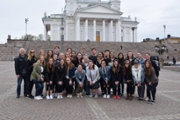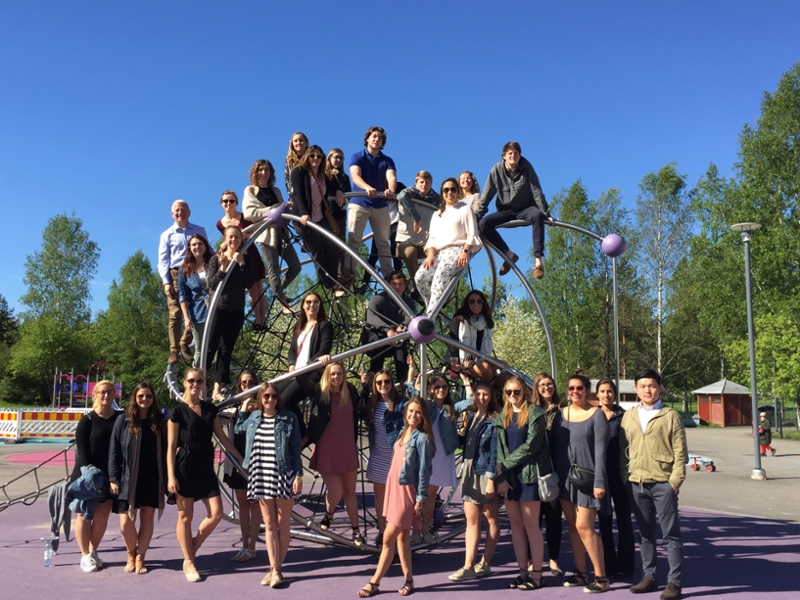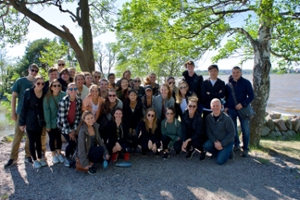Studying abroad in Luxembourg, Miami University's home away from home


James M. Loy, Miami University
Listen to the audio podcast
Read the story
After his first experience at Miami University’s Luxembourg campus, it wasn’t long before Jeffrey Wanko and his family began planning their second.
And then their third.
“I went in 2007 to supervise student teachers across Germany, but we stayed at the university’s chateau in Luxembourg when we were not on the road,” says Wanko. “It was a really neat place. I really liked the idea of spending time in a place with students and talking about content that they were really excited about. So I designed and proposed two courses to teach there and I was fortunate to be selected.”
Wanko, a Miami University associate provost and professor of teacher education, taught in Luxembourg during the 2011 – 2012 academic year and now he’s back home again, fresh from his most recent visit this past academic year.
“I was the first person to get to do this from my department in teacher education,” he says. “And that, I think, has helped others begin to think about it. We want to make that available to other people.”
At Miami, the Luxembourg program represents one of the most significant and immersive intercultural experiences available. In fact, Miami’s Luxembourg chateau, also known as the Dolibois European Center, is actually regarded as the university’s “fourth campus.”
Learning in Luxembourg
The program is open to all majors and disciplines, and participants can study or teach for a term or an entire year. There are some reoccurring classes, but the curriculum is mostly designed by faculty who propose courses that reflect their own academic expertise. The only requirement is that every class flows around a European-centric motif.
So coming from Miami’s College of Education, Health and Society, Wanko proposed courses that aligned with his background in mathematics and teacher education.
One was a mathematics history course. The other was a comparative education course, which also allowed Wanko to accentuate the similarities and differences between American and European school systems by organizing a study tour in Finland.
“To actually be there and take people to schools in another country was really powerful,” Wanko says. “Finland scores very high on international comparisons. The students there do very well, and yet they don’t go to school as many hours in a day. They have a lot of free time and they study a lot of different things. The elementary students have a lot of unstructured playtime. The focus is on the whole learner.”
“In the U.S.,” Wanko continues, “we often say we teach ‘math’ or we teach ‘language.’ But in Finland, and in other countries, they will say, ‘We teach kids.’”
This, of course, would be an ideal intercultural class for teaching majors. But Wanko believes that learning about other educational systems can be enlightening for all students, especially within an intercultural context.
Most Miami students, regardless of major, will support local school districts and may have children of their own. And, by using Finland as an example, Wanko helps them understand what else is possible.
In Finland, it goes beyond an emphasis on academic content. There, it’s also about the community collective, and about learning how to teach and engage kids from a deeper, more holistic perspective.
“It was refreshing,” says Miami senior Mira Alexander. “Even though these classes weren’t in my major it is nice to have the opportunity to pursue other interests. So the education class brought light to an area that I now think is really important. As a kinesiology major, I never would have thought about that.”
Small country, big opportunities
People often wonder how Miami University, a liberal arts college surrounded by rural Ohio farmland communities, found a home in Luxembourg, a small European country bordered by France and Germany.
But, really, it was Luxembourg that found Miami.
Miami’s Luxembourg campus at the Dolibois European Center is named after John Dolibois. Originally born in Luxembourg, Dolibois enrolled as a Miami student in 1938. He would eventually serve as Luxembourg’s U.S. ambassador and it was his deep affection for the university that led him to become a strong advocate for the partnership.
Today, the center represents the oldest American program in Luxembourg. Next year it will celebrate its 50th anniversary, and every year participants enjoy an exciting intercultural atmosphere that’s still reminiscent of the Miami experience back home.
All courses and grades count as if they were earned in Ohio, but along with the college credit also comes the multitude of immersive opportunities.
Most students discover European life as a local, and they participate in numerous cultural events and festivities. On the weekends, they travel. Paris, Berlin, and London are popular destinations. But on overnight trains, some adventurous students are able to venture as far as Budapest and Prague.
And while in Luxembourg, Miami students live with host families, who may or may not speak the same language, which can push even the furthest boundaries of almost anyone’s comfort zone.
“It is extremely powerful for students to get that chance to broaden their understanding of the world,” Wanko says. “I have seen that growth for students who learn to respect other people and their ways of doing things and ways of thinking about things. It’s really wonderful.”
For students like Alexander, the experience has been more than transformative. It’s been reverential, even.
“Having that sense of independence that comes from being far from home and exposed to so many different cultures really made me feel changed for the better,” she says. “I have a new perspective on the way I handle school, even the way I watch the news. Without that time studying abroad, I don’t think Miami would have meant as much to me as it does now. You are not going to get this experience anywhere else.”

